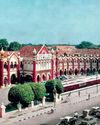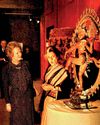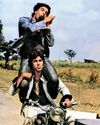
Arati Das watches her step as she sets foot into her room, for she can easily knock over the earthen pot of rice kept by the door. It’s a cost Arati can hardly bear, for she can afford to cook only once a day. The 42-year-old was forced to take up a job as a seamstress after the local panchayat stopped providing her employment under the Mahatma Gandhi National Rural Employment Guarantee Scheme (MNREGS). Her husband Dilip, 50, works at a garment factory. “Earlier, I’d earn Rs 3,000 extra every month. Now, my income varies between Rs 500 and Rs 1,000,” says Arati. The family, from Bilkanda I gram panchayat in the North 24 Parganas district, struggles to make ends meet on the meagre Rs 6,000-Rs 7,000 Dilip earns.
The NREGS or the 100-day job scheme provided income to a sizeable section of West Bengal’s population. While around 13.6 million people have valid NREGS job cards, only 9.2 million of the cards are active. This means at least as many people depend on the scheme for their livelihood.
However, the Union government has frozen the wages accrued till December 2021 under NREGS. Ever since it imposed the punitive Section 27 of the NREG Act—which calls for the withholding of funds in the event of irregularities—on the state on March 9, 2022, no new job days were created either. Arati is just one of 2.1 million people who have yet to receive payment for the last leg of work they had done till December 2021. The net amount due as NREGS wages in Bengal is Rs 3,732 crore. Add non-wage payments, and the amount doubles to Rs 6,907 crore. The non-payment of wages for the central job scheme has led to massive joblessness, pushed thousands into penury and resulted in large-scale migration out of the state.
Esta historia es de la edición October 16, 2023 de India Today.
Comience su prueba gratuita de Magzter GOLD de 7 días para acceder a miles de historias premium seleccionadas y a más de 9,000 revistas y periódicos.
Ya eres suscriptor ? Conectar
Esta historia es de la edición October 16, 2023 de India Today.
Comience su prueba gratuita de Magzter GOLD de 7 días para acceder a miles de historias premium seleccionadas y a más de 9,000 revistas y periódicos.
Ya eres suscriptor? Conectar

He gave the beat to the world
He would pick up the rhythms of each experience of mobility and weave them into his taals. Thus it was that he reflected joy and laughter in rhythmic cycles...such was the magic of Zakir's fingersText and photographs by Raghu Rai

KERALA TOURISM CAMPAIGN, 1989 - TICKETS TO PARADISE
All it took was a catchy tagline-'God's Own Country'-for the world to discover Kerala's wealth of natural beauty. It remains among the best tourism ad campaigns, earning the state a place among top 10 international destinations

SPIRITUALITY - THE GURUS OF COOL
Among the cult Indian gurus, no one had a bigger hold on western minds than 'Osho' Rajneesh. He's also perhaps the role model for the enterprise-building gurus of today

RETAIL SHOPPING - THE MALL MANIA
Shopping malls, a 1990s innovation in India, changed the way the Indian middle class shops. Their success now lies in being 'shoppertainment' destinations, offering something for everyone

CULINARY RENAISSANCE, 1978 - TANDOORI NIGHTS
ITC's Bukhara and Dum Pukht turned the world to tandoori cuisine and had an enormous impact on the F&B industry. Decades on, they are still a pit-stop for celebrities and heads of state visiting Delhi

INDIAN WRITING IN ENGLISH - REVENGE OF THE NATIVE
Rushdie lit the way but Indian writing in English has taken a life of its own in the past few decades, with translated Indian fiction most recently having its moment in the sun

INDIAN ART - A BRUSH WITH GOLD DUST
The 1990s economic liberalisation came as oxygen, lighting up the Indian art scene. Today, artworks by established masters routinely go for astronomical amounts

FESTIVAL OF INDIA, 1982 - CULTURE CAPITAL
The Festival of India grew into a symbol of our 'soft power', introducing our art and aesthetics to a global audience while also helping rebrand our domestic products

THE INDIPOP TREND - DISCO GOES DESI
For ages, the film song ruled. Nothing else was audible. Then came Nazia, charioteered by Biddu, and Indian ears went into a pleasant madness. Literally, Disco Deewane. A whole genre was born

SHOLAY 1975 - THE BIRTH OF THE FANDEMIC
India had seen hits before. But Sholay seared into its collective psyche like a badland bullet. The effect was on a scale never seen before- one film creating a new mass folk culture. And a trail of monster blockbusters that still continues